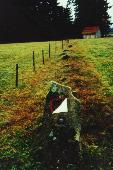Franz Lindenmayr / Man and Cave
Holed Stones and Crawling
Through Rituals in Austria
A few notes:
Bucklwehlucke,
Upper Austria
"The
so-called Blasenstein, an enormous, almost round rock,
which is also called Phallusstein, is supposed to be a
pagan cult place. The old cult rock is situated near the
church of St. Thomas. The stone block is divided by the
famous cleft. It is said, that you should use the
entrance to the east, when you want to practise the
through-creeping rite. In the closest place the gap is so
narrow that thick persons got stuck and had to be saved
by the firebrigade. Some people believe that the stone
has healing power. By the contact with the holy stone one
expected health for body and soul. Thus it is called
"Bucklwehstein", because it should particularly
bring ease with pain of the back. Today the ritual
meaning is lost to a large extent, and it is now widely
considered just as a funny custom to squeeze through the
gap." (Jantsch, Franz, Kultplätze in Upper Austria
and Salzburg, Unterweitersdorf 1994)
 |
 |
Foto Adelung |
- Rochushöhle, Lower
Austria
"In the south
flank of the west back of the Dietrichhagriedels north of
Grossreifling. Marked access path. Length 22 m, height 12 m. The
cave can be entered through the artificially extended entrance in
which a devotion place with an altar, dedicated to Saint Rochus,
is built. A staircase leads to a small platform, from which one
gets to the roomy, steeply rising rear part of the cave. At the
west side of the entrance, near a rock column and somewhat more
highly situated is another tight entrance, through which you can
squeeze yourself. It is accessible from the outside by a wooden
construction which leads to it. This place was used a
"Durchschlupfstein". There is still a strong faith in
the healing powers of this place which is confirmed by the many
inscriptions of local people in the book at the entrance. (after
Hartmann, H. and W., The Caves of Lower Austria, Volumne 3,
Vienna 1985)
"In the
so-called Matterhörndl, in former times Pfennigstein, an approx.
10 m high rock 50 m east of the forest road from Moedling to the
Husarentemple. Length 3 m. Man-high passage connected with many
legends. Usage as crawling-through place for healing of diseases,
fertility cult. The rock is a nature reserve since 9 April 1941.
(Hartmann, H. and W., The Caves of Lower Austria, Volumne 2,
Vienna 1982, further references in Volumne 4, p. 414)

3 km north of Kössen
in Tyrol, quite close to the Bavarian boundary. The pilgrimage
church Klobenstein is in the narrow ravine of the Tiroler Ache.
That the pilgrimage takes place here is no coincidence, but on
the closest attached to the presence of the
"Klobensteins". An enormous rock fell down from the
mountains up long ago and remained lying there, split in two
pieces. Now you can pass through the narrow sections between the
stones.
A legend of the
origin of the nature phenomenon tells of a miracle that the vault
in the stone occured exactly then, when a woman had been on her
way home from Kössen to Marquartstein. The huge block broke
exactly in the moment, when the woman would have been crushed by
it.
The earliest
documentary recordings about this place originate from the year
1696...
Literature:
Wallfahrtsbüchlein, Geschichte von Klobenstein bei Kössen in
Tirol, mit kirchlicher Druckerlaubnis im Selbstverlage der
Wallfahrtskapelle, 16. edtion, 1996)
see also the German version
https://www.raetiastone.com/
Holed Stones and
Crawling through rites
Höhle-Religion-Psyche